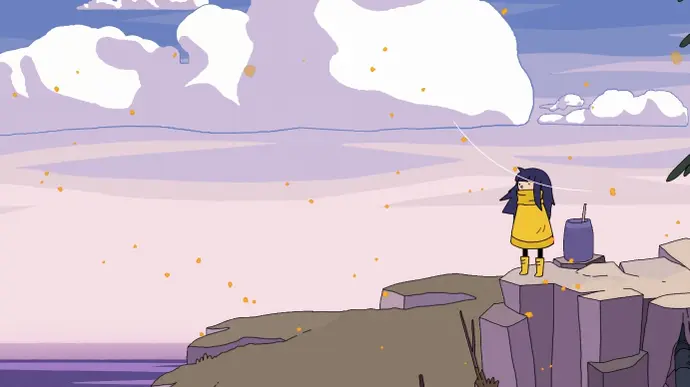
Although Minute of Islands is a lovely game, the gameplay is slow and lacks a cohesive story.
As I consider Minute of Islands, I find myself at a crossroads. I’m not sure whether I really like this sort of game, even if I typically would have. Rather, I discover that only one day after playing, I’m already beginning to forget about it.
The initial impression of Minute of Island is indeed remarkable, since its overall tone deviates much from what one would anticipate given its artistic flair. According to the narrator, one morning, as a young woman called Mo, you wake up to quiet when there definitely ought to be noise—the sound of subterranean machinery humming, powering the fans that keep the islands clear of spores that are fatally deadly.
It’s an amazing experience to see what’s driving the fan for the first time: a massive, subterranean colossus whose only function seems to be turning a crank like a hamster in a wheel. However, the enormous brother has become weary, resulting in a destructive series of equipment malfunctions. As the keeper of the omni switch, a hybrid admin master key that is both magical and mechanical, Mo’s job is to restore order by rerouting emergency power to many fans around her little archipelago.
The goal of the game is to first get the favor of these supporters. The closest thing Minute of Islands has to offer as a platformer is probably the fact that you mostly simply attempt to navigate the 2D side-scrolling settings, however sometimes you do hop from platform to platform. These settings are stunning, brimming with minute details such as the strewn-about mess of a well-loved home or the crumbling remnants of a theme park.
Observing them through Mo’s eyes reveals the tale of long-abandoned locations that, for some reason, she still feels accountable for. You then ascend hills and platforms until you reach the mechanical fans, moving at a somewhat slow pace because the air is full with lethal spores and there are many dead bodies from the lives it has already taken. The seamless nature of the graphics makes it difficult to discern where you can climb up and down, even though most climbable surfaces are indicated with some white muck and sometimes a moving object receives a minor effect to indicate that as well.


An ubiquitous narrator gives Mo’s thoughts and deeds voice at all times, but I hasten to add that this narration seems quite different from that of Biomutant, the other narrated game of the hour. This is evocative, well-acted material that never becomes too intrusive. Reaching a fan requires pressing a series of buttons in order to restart it: spin a crank, plug the omni switch in, attach a glowing line of energy to the fan, and pump energy into it.
When Mo performs it, it seems to be repetitive, easy work since it’s one of the rare occasions you see her arms show through the folds of her yellow coat. Regretfully, playing it seems no more thrilling. Mo breathes in so much of the yellow spores that she becomes disoriented in her hallucinations as she travels over them on her boat between islands. You must gather a few bright, flying sea animals in order to escape the mirages the fungus causes her to perceive. Generally, this involves moving from one end of the screen to the other until you come across them, then mounting a platform to get near enough to grab them. Sometimes you have to dodge one of these animals until you find the correct one in order to complete the sequence correctly, but generally, these sequences are so brief and easy that there is nothing even somewhat strenuous about the workout. These sections seem to be intended to provide a somewhat distinct gaming experience, although they really don’t and are also mostly detached from the story.

I was curious to learn more about Minute of Islands’ universe when I first began playing it. I wanted to know how it came to be in such disarray, why a young lady would choose to live underground to keep things running even though there was a strong indication that she could simply go like everyone else, and who else was there with her. The game does a fantastic job of conjuring up the atmosphere of a once-vibrant society that had immense emotional meaning for its protagonist, but that’s all it is: a hodgepodge of hazy allusions and recollections, many of which are even collectible.
I don’t usually prioritize gaming above storyline; if a compelling tale is waiting for me, I usually don’t mind light gameplay as long as there’s other compelling elements, like a compelling mystery or endearing characters. I never seek out true challenges; instead, I seek out that sweet spot where taking action still counts and makes a difference in the status of the world I visit. Why create an engaging experience if not?
However, Minute of Islands is unable to commit to either; it is a six-hour game without both a substantial gameplay concept and a true plot. The game ends without saying anything unpleasant, which is unusual for a game that has a trigger warning. When I’m done, it seems like the prologue to a much larger narrative since all these issues that I was eager to get the answers to are hardly addressed. This is unfortunate because I believe all the elements are there: a powerful atmosphere enhanced by a sparse soundtrack, striking visuals, and a heroine who can’t just keep living her life in one place. However, the journey is brief, frequently resembling a bad day at a job she doesn’t enjoy, and when I leave, I don’t feel particularly connected to anything I’ve just gone through, despite Minute of Islands’ assurance that I would be shocked and catharsed by discovering dark, hidden secrets.